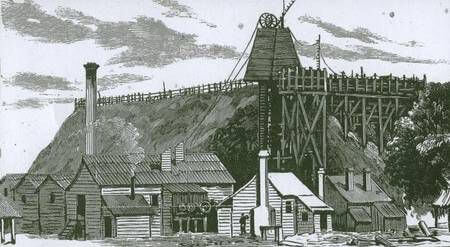Australasian Mining Disaster
New Australasian No.2 Gold Mine Disaster

No one would imagine that in the small but prosperous town of Creswick in 1882 there would occur to this day the worst gold mining accident in Australia. Like the modern day accident at Beaconsfield, relatives, friends and onlookers would wait at the mine-head anxious for news. Whilst rescue in Creswick would occur within three days (unlike the fortnight it took to rescue the miners at Beaconsfield), 22 men would not return to their family. It would leave 18 widows and 63 orphans. Forty-one men entered the Australasian No.2 Mine for the night shift on Monday, 11th December 1882 but in the early hours of the morning water flooding from the old site of the No.1.Mine trapped 27 men. The noise of the flooding was heard above ground and immediately the engine driver James Spargo began to increase the speed of the pump. He was soon joined by the other two engine drivers – James Harris and Thomas Clough. The Mine Manager William Nicholas, who was asleep when the accident happened, was soon on the scene. By 9.30am the news was circulating Creswick, and people started to congregate at the mine. By midday word was circulating from the mine to other towns and villages and eventually circulating further then the Colony of Victoria. The trapped miners managed to reach the very small space of the No.11 jump-up. There they huddled together in darkness, singing hymns and praying for deliverance and for their love-ones. Some wrote messages on their crib pails to their families. The Bellingham brothers tied themselves together. When the rescue came Thursday morning unfortunately it was too late for 22 men (one body was still warm) and only 5 men came out alive from the foul smelling dark mine. Their funeral took place the next afternoon. John Thom Clifton forecasted that their funeral would be the biggest ever held in Creswick was proved right. About 4,000 people marched in the procession, including 2,000 members of the Miners’ Association, with 15,000 onlookers. 19 are buried in Creswick Cemetery. Similar to the Black Saturday Bushfire Fund an appeal was started for the widows and orphans. Money was collected from towns and villages all over Victoria and soon amounted to £20,000. The widows received 15 shillings per week and the orphans from 5 to 1 shilling until they started employment or reached 17 years. Within two years Parliament had changed the fund to “The Mining Accident Relief Fund Act, 1884” for the benefit of all victims of mining accidents. The Fund was finally wound up in 1949 long after the last widow had died. A memorial was erected 17 years later in the Cemetery. In 1949 when the fund was wound up saw £100 given to the remaining orphans and Michael Carmody the lone survivor of the accident. A majority of the money was divided between three hospitals Bendigo, Ballarat and Creswick. Creswick received £12,000.00.
List of the Dead
- Christian Frederick Fisher (55) Wittenburg, Germany
- James Carmoody (53) County Clare, Ireland
- George Baulcomb (52 & 10 months) Maidstone, Kent, England
- Nathaniel Trescowthick (45) Cornwall, England
- Michael Hayes (45) Ireland
- John Gower (44) Lyminge, Kent, England
- William Curtis (42) Gwennap, Cornwall, England
- James Minahan (38) County Clare, Ireland
- William Tregloan (37 & 6 months) Marazion, Cornwall
- Edward Campon Dargon (36) Kilkenny, Ireland
- Anton Andersson (36) Christianstada, Finland
- John Henry Crougey(35) Stithians, Cornwall, England
- James Mitchell Temby (35) Redruth, Cornwall, England
- James O’Shea also known as James Walsh (34years & 11 months) County Waterford, Ireland
- Carl Waldemar Theodor Serrurier (34) Berlin, Prussia
- Thomas Penbertha Chegwin (31) Redruth, Cornwall, Ireland
- Abraham Wyatt (31) Adelaide, South Australia
- Jabez Bellingham (28) Worcestershire England
- Benjamin Bowen Bellingham (21) Happy Valley, Victoria.
- John Tom Clifton (27) Gainsborough, Lincolnshire, England
- Edward Wood (26) Oldham, Lancashire, England
- John Thomas Hodge (18) Creswick
Survivors
- Peter Maloney
- John Manley died 25/1/1924
- Tom Corbett died 31/5/1935 Creswick
- Cornelius Quirk died Feb. 1922 Milawa
- Patrick Bowen died 26/3/1909 Creswick
Working in the Mine at the time of the disaster but escaped the flooding
- John Hodge, Snr. father of John Hodge
- (Captain of the shift)
- George Fisher (Faceman)
- Henry Reeves (Contractor)
- William Mason (Contractor)
- Michael Carmody (Platman) son of James Carmody
- John Woods (Trucker)
- Edmund Woods (Trucker)
- Hugh Crosbie
- Alf Trelor
- Charles Menner (Faceman)
- Garton
- Taylor
- Henry Polglase (Trucker)
- Gunther
Engine Drivers working the Pumps
- James Spargo (On duty at the time of the accident)
- James Harris
- Thomas Clough
Other Workers
- Thomas Clarke (Pitman)
- George Lowe
- William Carbis (Shift captain)
- William Townsend
- Robert Egglestone
- William Nichols, Jnr (helped in the office)
- Andrew Robertson (Manager Davies’ Junction Mines)
Medical Team
- Dr. Charles Lindsay
- Dr. Lyons
- Dr. John Tremearne
- Dr. Bell
Amalgamated Miners' Association
- George Williams (President) Ballarat
- William Guthrie Spence (Secretary)
Volunteer Fire Brigade
- Piening (ex Captain)
- H. Wood
- W.Herriot
- G. Painter
H.M.S. Cerberus
- Divers Trusker
- Divers Meyers
- Attendant Mexham
- Attendant Mewes
Spiritual Comfort
- Rev. Charles Robinson
- Rev. Thomas Williams (Wesleyan)
- Rev. John Glover (Anglican)
- F.C. Vian (Primitive Methodist)
- W. Bettiss (Bible Christian)
- Fr. O’Brien (Roman Catholic)
Inspector of Mines
- Charles Stewart
Benefactors
- Mrs. J.T. Jebb
- Mrs. W.P. Jones
Coroner's Court
Coroner
- J.C. Thomson, P.M.
Jury
|
|






